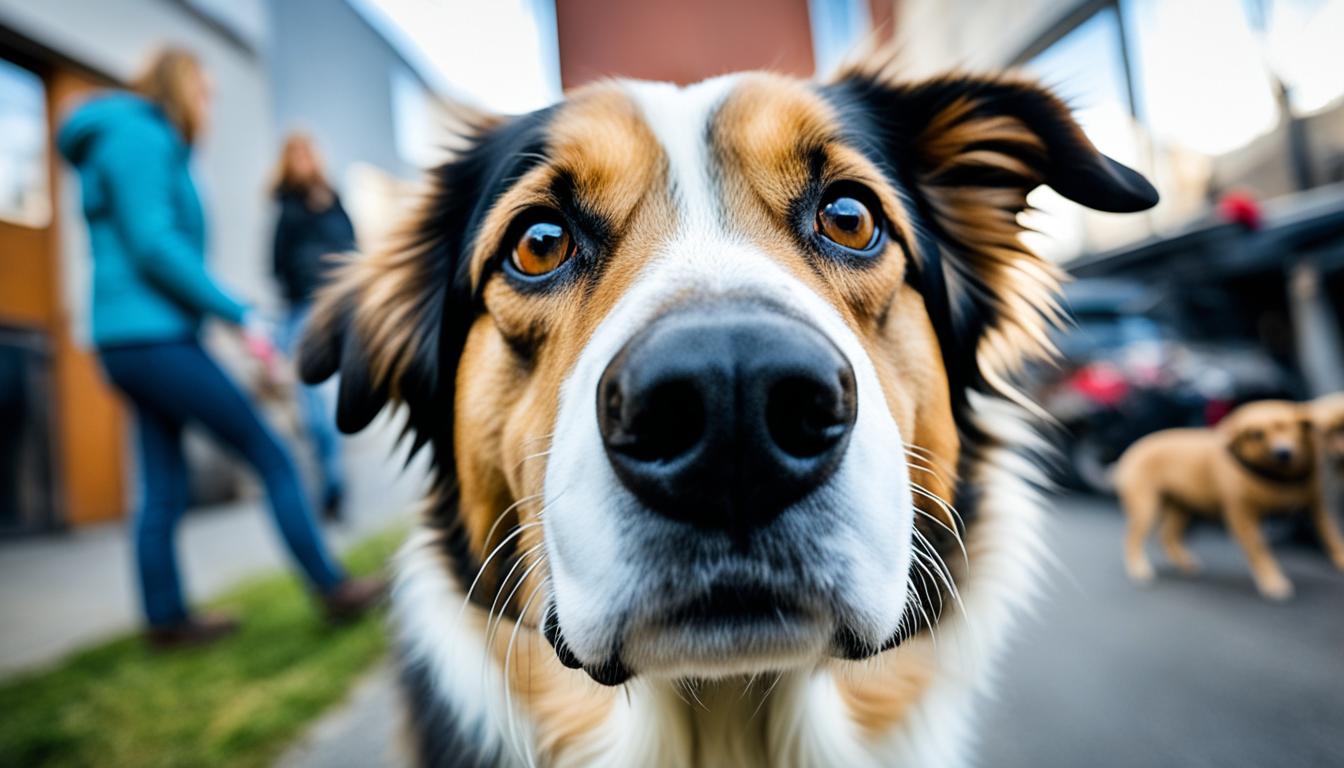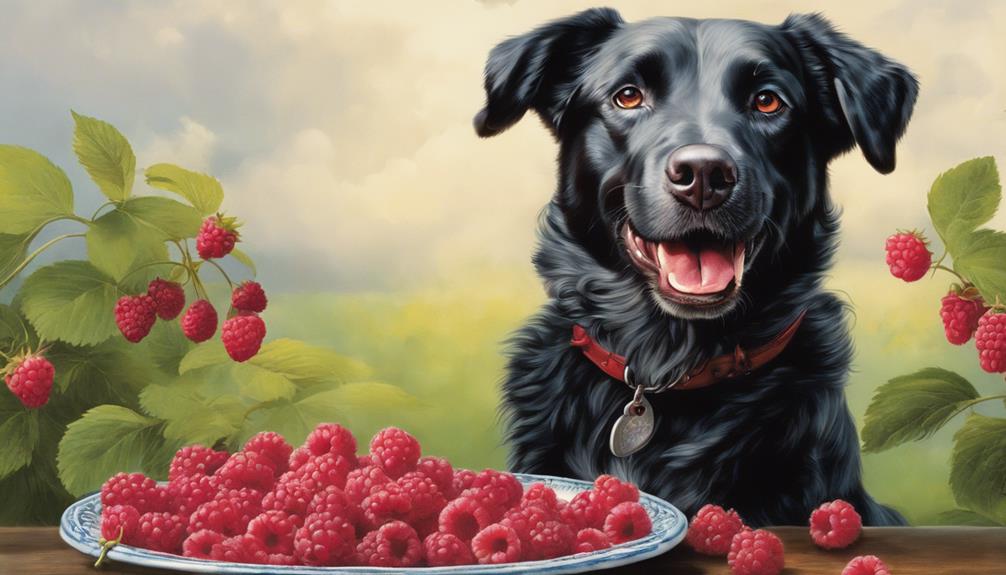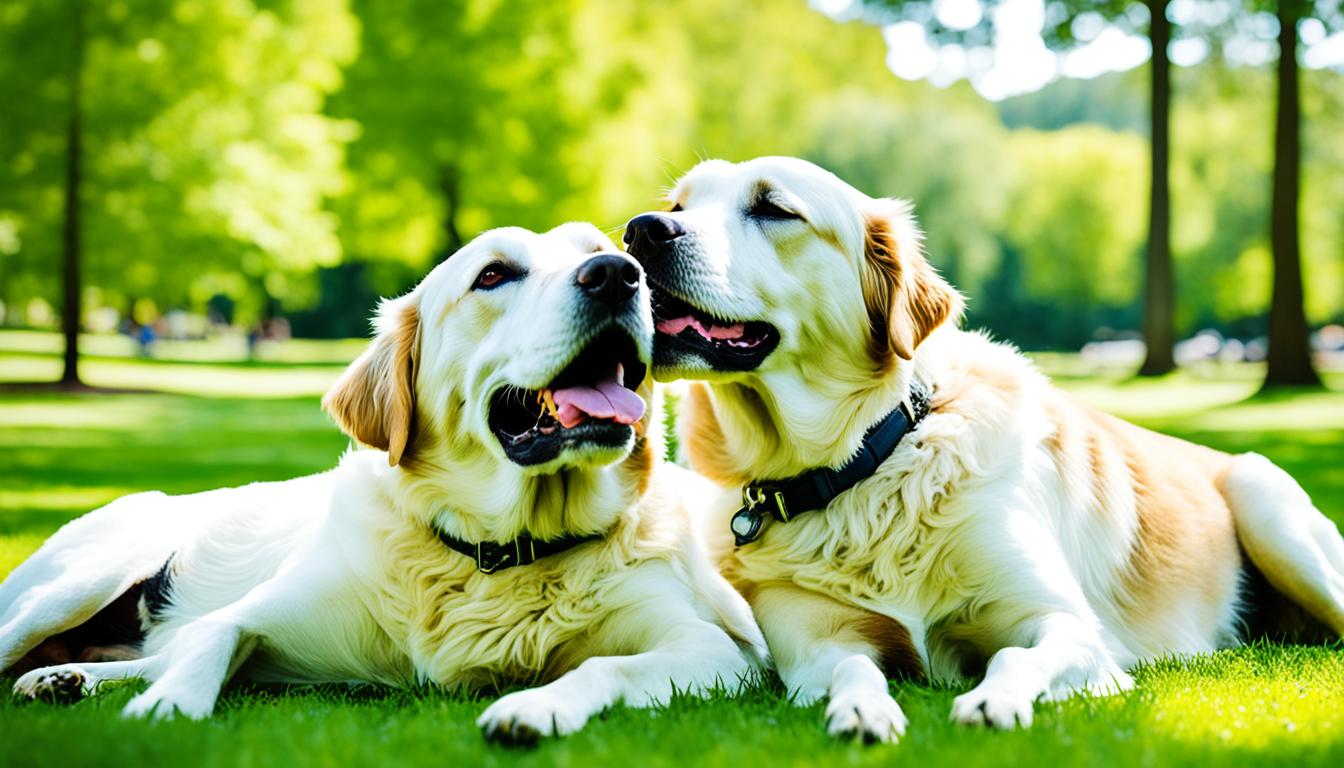Did you realize that dogs have an amazing knack for detecting negative energy? That’s right! As per multiple sources, our beloved furry pals possess a natural instinct to detect pheromones and other signals that warn them of possible threats. This extraordinary sensing skill is thought to be connected to their heightened senses of smell, hearing, and intuition.
In this article, we will delve deeper into the science behind dogs’ ability to sense energy, the signs that indicate they are sensing negative energy, and how they use their senses to protect us. We will also explore whether their reactions to negative energy always indicate imminent danger, and the benefits of paying attention to their sensing abilities. So, let’s unravel the mysteries of dogs and their sixth sense for negative energy!
Key Takeaways:
- Dogs have the natural ability to sense negative energy through their heightened senses of smell, hearing, and intuition.
- They can detect pheromones and other cues that convey information about a person’s emotional state or the presence of danger.
- Signs that a dog senses negative energy include behaviors like pacing, whining, growling, or avoiding a person or situation.
- Though dogs’ reactions to negative energy can indicate potential danger, it’s essential to assess the situation to determine if there is a genuine threat.
- Understanding and acknowledging dogs’ reactions to negative energy can help strengthen the bond between owners and their pets and create a safer environment for everyone.
The Science Behind Dogs Sensing Energy
Dogs have highly developed senses, including their sense of smell, hearing, and intuition. These abilities allow them to detect and sense energy in their environment. Canines possess an extraordinary olfactory system, with up to 300 million scent receptors compared to humans’ mere 5 million. This keen sense of smell enables dogs to pick up on pheromones, which are chemical signals released by humans and other animals.
By detecting these pheromones, dogs can gather crucial information about a person’s emotional state and potential threats in their surroundings. Pheromones can convey a range of emotions, including fear, anxiety, and aggression, which immediately trigger dogs’ behavioral responses. This explains why dogs often exhibit behaviors such as whining, barking, growling, or even aggression in certain situations.
In addition to their sense of smell, dogs also rely on their exceptional hearing to sense energy. They possess ears with superior structure and sensitivity compared to humans, enabling them to detect sounds in a wider frequency range. Dogs can hear sounds at higher frequencies and lower volumes, allowing them to pick up subtle cues that may indicate a change in energy. These auditory cues, combined with their heightened sense of smell, enhance their ability to sense and react to energy in their environment.
Furthermore, dogs have a natural intuition that aids in their sensing abilities. Their instincts have been honed through generations of domestication and close companionship with humans. This intuition allows them to sense subtle shifts in energy and behavior, enabling them to understand and respond to their human counterparts’ emotional states and overall energetic atmosphere.
Overall, dogs’ ability to sense energy is a result of their highly developed senses of smell, hearing, and intuition. Their keen perception of pheromones, auditory cues, and intuitive sense contribute to their remarkable canine ability to sense energy in their environment.

Signs that Dogs Sense Negative Energy
When dogs sense negative energy, they may exhibit various behaviors that can clue their owners in to the fact that something is amiss. These behaviors can include:
- Backing away from a person or situation
- Pacing
- Tucking their tail between their legs
- Shaking
- Whining or whimpering
- Flattening their body on the ground
- Holding their head low
- Staring intently
- Raising their hackles
- Edging closer to a person or situation
- Staying close to their owner
- Trying to escape the situation
- Growling
- Snapping
These behaviors can vary depending on the individual dog and the intensity of the negative energy they are sensing. It’s important for dog owners to be observant and familiar with their dog’s normal behavior in order to recognize these signs and respond accordingly.
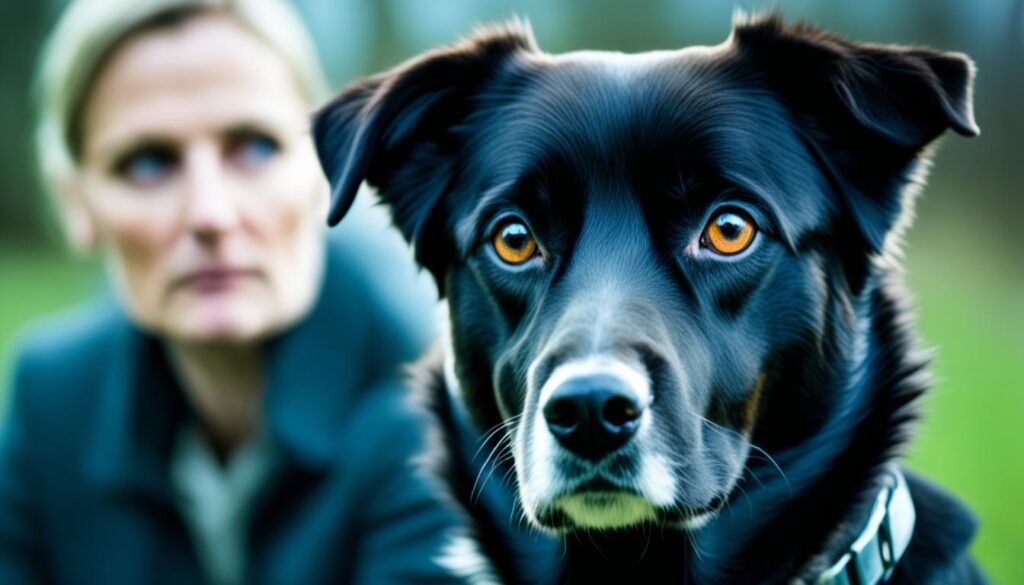
Does Dogs Sensing Negative Energy Always Mean Danger?
While dogs have the incredible ability to sense negative energy, it’s important to understand that their reactions don’t always indicate an immediate danger. Dogs can pick up on various cues and react to them in different ways, but their responses may not necessarily mean there is a genuine threat.
It’s crucial for dog owners to interpret their dogs’ reactions to negative energy carefully. Sometimes, dogs may react negatively to harmless things or situations due to their unique perception. For example, a dog may bark at a person wearing a hat because the hat appears unfamiliar or threatening to them. Similarly, they might react adversely to loud noises such as thunder or fireworks, mistaking them for potential danger.
Understanding and assessing a dog’s behavior when encountering negative energy is essential to differentiate between a genuine threat and a misunderstanding. By observing their body language, vocalizations, and overall demeanor, we can better interpret their responses.
It’s important to note that interpreting dogs’ reactions to negative energy requires context and observation. Factors such as the dog’s body language, the specific situation, and its previous experiences can significantly influence their responses. Pet owners play a vital role in determining the true nature of the situation and providing reassurance to their dogs.
Remember, dogs have their own unique ways of perceiving and reacting to the world around them. Their ability to sense negative energy is remarkable, but it’s crucial to interpret their behavior in the appropriate context to ensure their well-being and create a harmonious environment for both pets and their owners.
Comparing Dogs’ Reactions to Negative Energy
| Behavior | Interpretation |
|---|---|
| Barking or growling | Alerting potential danger |
| Pacing and restlessness | Indication of anxiety and unease |
| Whimpering or shaking | Signs of fear or distress |
| Tail tucked between legs | Display of submission or fear |
| Staring intently | Heightened vigilance |
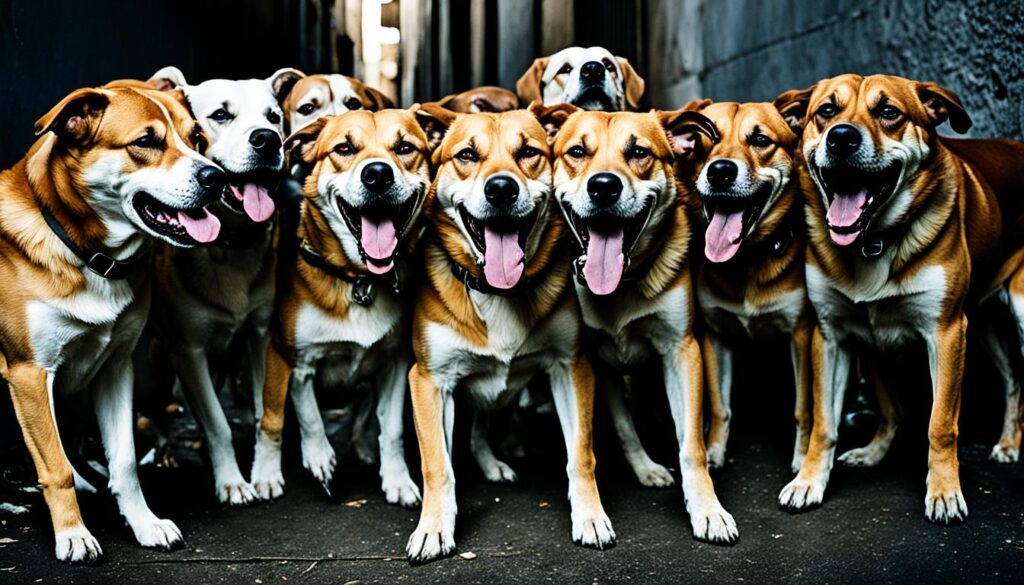
Dogs Sensing Negative Energy and their Protective Instincts
Dogs have remarkable protective instincts that are enhanced by their ability to sense negative energy. They serve as loyal companions and can act as an early warning system for their owners, alerting them to potential dangers. Dogs possess heightened senses and intuition, allowing them to detect changes in the atmosphere, sense approaching storms or earthquakes, and even detect medical issues in their owners such as seizures or diabetic attacks.
This inherent ability to sense danger stems from dogs’ natural protective instincts, which are deeply ingrained within their DNA. Throughout history, dogs have been relied upon for their vigilance and alertness, often serving as guardians and protectors. Their acute senses, including their exceptional hearing and sense of smell, enable them to detect even the slightest changes in their environment, making them highly attuned to potential threats.
When a dog senses negative energy, whether it’s from a person or the environment, they may exhibit specific behaviors that signal their awareness of potential danger. These behaviors can include intense staring, raised hackles, growling, or positioning themselves between their owner and the perceived threat.
It’s important for dog owners to understand and respect their pets’ protective instincts. By paying attention to their dogs’ reactions, owners can take necessary precautions to ensure their safety. Trusting a dog’s instincts can provide an added layer of security and peace of mind.
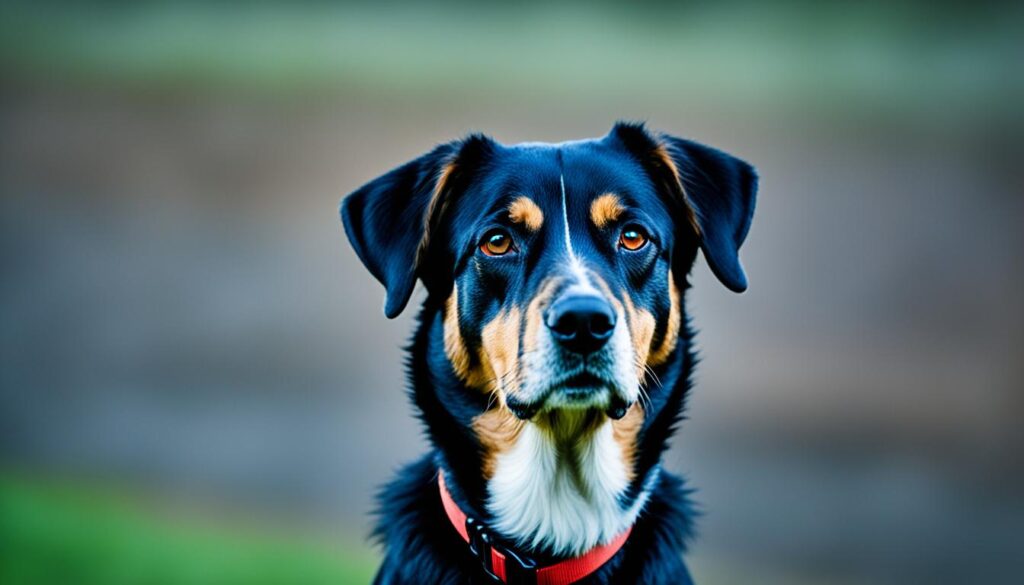
“Dogs have a natural instinct to protect their owners from harm. Their ability to sense negative energy allows them to act as a reliable and intuitive early warning system, ensuring the well-being and safety of their human companions.”
– Dr. Emily Johnson, Animal Behaviorist
These protective instincts and sensing abilities make dogs invaluable companions in various situations. For example, during natural disasters, dogs have been known to sense earthquakes or detect changes in atmospheric pressure that precede storms, allowing their owners to take necessary precautions or find shelter.
Additionally, dogs have demonstrated their ability to detect medical issues in their owners. For individuals with conditions such as epilepsy or diabetes, dogs have been trained to recognize specific odors associated with an impending medical event. These trained dogs can provide early alerts, giving their owners vital time to take appropriate actions or seek medical assistance.
Furthermore, dogs contribute to the overall well-being and emotional support of their owners. Their comforting presence can help alleviate stress, anxiety, and feelings of negativity. By simply being there, dogs provide a sense of security and unconditional love, helping their owners navigate through challenging times.
In summary, dogs possess innate protective instincts that are strengthened by their ability to sense negative energy. They act as guardians, utilizing their heightened senses to detect potential dangers and alert their owners. Dogs’ protective instincts and sensing abilities make them invaluable companions, enabling them to serve as early warning systems, detect medical issues, and provide emotional support.
Can Dogs Sense Emotions?
Dogs have an extraordinary ability to sense and detect human emotions. They are highly perceptive creatures, capable of picking up on subtle cues and changes in their owners’ demeanor. Whether it’s sadness, stress, or excitement, dogs have a unique knack for understanding and responding to their owners’ emotional states.
Dogs can sense emotions through a combination of their acute senses and their deep connection with their owners. They can detect changes in speech patterns, tone of voice, and body language. Even the slightest shift in posture or a subtle scent change can signal to a dog that something is amiss. They can also sense the energy and vibrations that humans emit when they are experiencing strong emotions.
When it comes to sensing emotions, dogs are masters of intuition. They can often sense sadness before it is even expressed and will instinctively respond with empathy and comfort.
When a person is feeling negative emotions, such as sadness or stress, their dog may exhibit mirroring behaviors or avoidant/reactive behaviors. They may cuddle up to their owner, offer gentle nudges, or simply sit quietly by their side. In contrast, some dogs may detect tension or anxiety and prefer to give their owner space until they feel better.
Dogs’ ability to sense and respond to human emotions can be incredibly beneficial. They can provide comfort and support during times of emotional distress, acting as a source of solace and companionship. Studies have shown that spending time with a dog can reduce stress, lower blood pressure, and boost mood. It’s no wonder that dogs are often referred to as “man’s best friend.”
So, the next time you’re feeling down or overwhelmed, remember that your loyal canine companion is there to lend an empathetic ear and a comforting presence. Dogs truly have a special gift for sensing and understanding our emotions, making them invaluable companions in our journey through life.
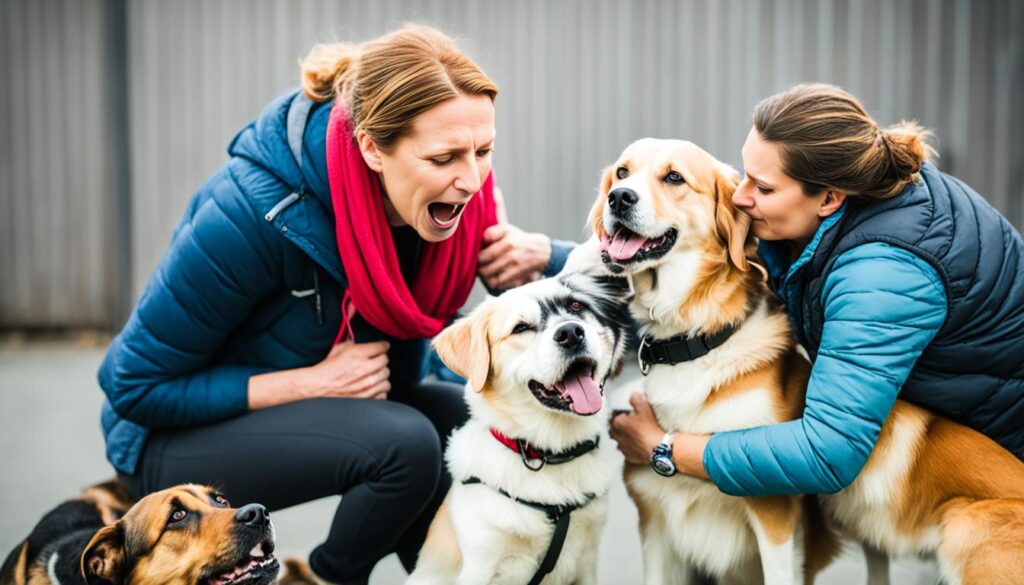
Benefits of Dogs Sensing Emotions
- Offering emotional support during times of distress
- Reducing stress and anxiety levels
- Providing companionship and a sense of security
- Boosting mood and overall well-being
- Acting as non-judgmental listeners
Dogs’ Senses and their Role in Sensing Negative Energy
Dogs have superior senses compared to humans, which allows them to sense negative energy effectively. Their sense of smell, hearing, and intuition are highly developed.
Let’s start with their sense of smell. Dogs have about 300 million scent receptors, while humans only have around 6 million. This incredible sense of smell enables dogs to detect subtle changes in the environment, including pheromones released by humans and other animals.
Their acute hearing is another key factor in their ability to sense negative energy. Dogs can hear a wider range of frequencies than humans, and their ears are capable of pinpointing the source of a sound much more precisely. They can pick up on slight changes in tone or volume, allowing them to detect signs of stress, fear, or aggression.
Additionally, dogs have a strong intuition that helps them pick up on subtle cues from humans. They are highly attuned to our body language, facial expressions, and even our emotional state. Dogs can sense when we are anxious, upset, or stressed, and they respond accordingly.
“Dogs have a remarkable ability to interpret our emotions and sense when something is not right. They can pick up on our energies and react to negative situations in a way that protects us,” says Dr. Jane Wilson, a renowned animal behaviorist.
It’s important to understand that dogs’ senses work together synergistically. Their heightened sense of smell, hearing, and intuition allows them to detect and interpret negative energy in various forms and respond accordingly. Whether it’s picking up on pheromones, hearing changes in our voice, or sensing our emotional state, dogs have an innate ability to sense negative energy and alert us to potential dangers.
Enhanced Senses and their Role:
| Senses | Role in Sensing Negative Energy |
|---|---|
| Smell | Allows dogs to detect pheromones and subtle changes in the environment. |
| Hearing | Enables dogs to hear changes in tone or volume, alerting them to signs of stress or danger. |
| Intuition | Helps dogs pick up on subtle cues from humans, including body language and emotional state. |
When it comes to sensing negative energy, dogs truly have an edge over humans. Their heightened senses and ability to detect pheromones and pick up on subtle cues allow them to be our loyal protectors, providing us with early warnings and emotional support.

Dogs’ Ability to Detect Illness and Disease
Dogs have a remarkable ability to detect illness and disease in humans. Their keen sense of smell enables them to pick up on subtle changes in odor associated with metabolic changes in breath and skin. Through specialized training, dogs have been trained to sniff out various diseases, such as cancer and diabetes, by detecting specific scents present in samples. When a dog detects the scent of a disease, they display specific behaviors that indicate their discovery, such as pawing, barking, or sitting. This incredible talent makes dogs invaluable in disease detection and can potentially contribute to early diagnosis and treatment.
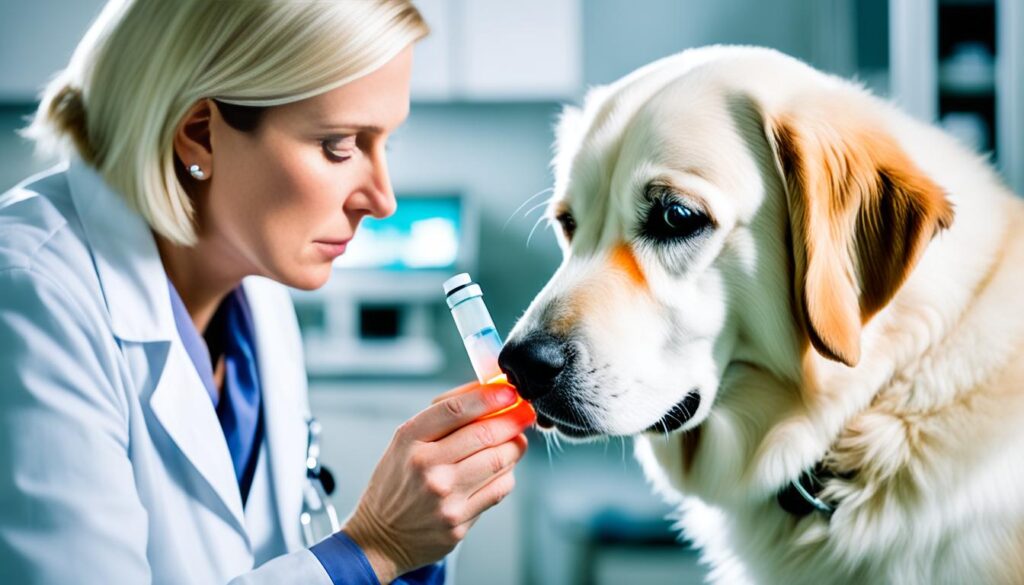
When it comes to detecting cancer, dogs have shown impressive accuracy in numerous studies. For example, a study conducted at the University of Pennsylvania’s School of Veterinary Medicine trained dogs to identify lung cancer in breath samples. The results were astounding, with the dogs correctly identifying samples from patients with lung cancer 99% of the time. Similarly, dogs have been trained to detect bladder, ovarian, and breast cancer, among others.
Data table – Dogs’ Ability to Detect Illness and Disease
| Illness/Disease | Dog Detection Accuracy |
|---|---|
| Lung Cancer | 99% |
| Bladder Cancer | 95% |
| Ovarian Cancer | 94% |
| Breast Cancer | 88% |
Additionally, dogs have been found to have the ability to detect other conditions, including diabetes. They can sense changes in blood sugar levels by detecting subtle odor changes on a person’s breath or skin. Once trained, dogs can alert their owners to dangerously low or high blood sugar levels, potentially preventing life-threatening situations.
Although dogs’ ability to detect illness and disease shows great promise, it is important to note that they are not a replacement for traditional medical diagnostic methods. However, their unique sensing abilities make them valuable companions in the realm of disease detection and can contribute to early intervention and better health outcomes.
How Dogs Can Sense and React to Negative People
Dogs have an incredible ability to sense negative energy emitted by certain individuals. In their own unique way, they can detect subtle cues and chemosignals associated with negative emotions. If someone is emotionally unpredictable or their negative attitude causes stress and anxiety, dogs can pick up on these signals.
When dogs sense negative energy, they may exhibit various behaviors to protect themselves and their owners. These can include avoidance behaviors such as backing away or hiding, or more aggressive reactions if they perceive a direct threat. Dogs are highly intuitive creatures and their natural response to negative individuals is a way of safeguarding themselves and those they care about.
It’s important to note that dogs’ reactions to negative people should not be taken lightly. These reactions are grounded in their instinctual desire to keep themselves and their pack safe from potential harm. As responsible dog owners, we should pay close attention to our dogs’ reactions and take them seriously.
To better understand how dogs can sense and react to negative individuals, it’s essential to recognize their heightened senses and emotional intelligence. Dogs have an advanced sense of smell that allows them to detect subtle changes in hormones and chemicals released by humans. They can also read body language and pick up on social cues, giving them insight into a person’s emotional state.
“Dogs have an incredible ability to sense negative energy emitted by certain individuals.”
Additionally, dogs have an innate ability to empathize with their owners and sense their emotions. They can detect changes in our tone of voice, body language, and even the scent of our sweat when we’re anxious or upset. When a negative person enters their space, dogs can detect the energy shift and react accordingly.
By recognizing and respecting our dogs’ ability to sense negative people, we can protect them from potential harm and create a safer environment for both them and us. It’s important to listen to our dog’s signals and remove them from situations where negative individuals may be present. We have a responsibility to advocate for our dogs’ well-being and keep them away from those who may cause them distress.
In conclusion, dogs possess an innate ability to sense and react to negative energy emitted by certain individuals. Through their highly developed senses, keen intuition, and emotional intelligence, they can detect chemosignals, read body language, and pick up on social cues that indicate a person’s negative attitude or emotional state. As responsible dog owners, it’s crucial that we recognize and respect their natural instincts and protect them from potentially harmful situations.

The Benefits of Paying Attention to Dogs’ Sensing Abilities
When we pay attention to our dogs’ sensing abilities, we unlock a world of benefits for both them and us. Dogs have an incredible knack for detecting potential dangers and providing early warning signs, allowing us to take necessary precautions. Their heightened senses and intuition enable them to pick up on subtle cues and changes in our environment, making them valuable protectors and companions.
One of the most significant benefits of understanding and acknowledging our dogs’ reactions to negative energy is the creation of a safer environment. By recognizing when our dogs exhibit behaviors such as barking, growling, or backing away, we can identify potential threats and take appropriate action. Whether it’s avoiding a certain individual, steering clear of a hazardous situation, or simply being more cautious, our dogs help us stay safe.
In addition to their role as protectors, dogs also provide us with emotional support and comfort. During times of distress or sadness, our dogs sense our emotions and offer solace. They can offer a listening ear (or rather, a listening ear), a warm snuggle, or a playful distraction when we need it most. Their unwavering loyalty and empathy make them excellent companions, helping us navigate through difficult times.
Paying attention to our dogs’ cues and reactions also strengthens our bond with them. By observing and understanding their behaviors, we develop a deeper connection and mutual trust. This heightened communication allows us to better anticipate their needs, adapt our training methods, and respond appropriately in different situations. It fosters a sense of teamwork and cooperation, creating a harmonious relationship.
“Our dogs serve as our faithful guardians, alerting us to potential threats, and providing comfort during challenging times. By paying attention to their sensing abilities, we can create a safe and nurturing environment for everyone involved.”
The Benefits of Paying Attention to Dogs’ Sensing Abilities:
- Early warning signs of potential dangers
- Emotional support and comfort
- A stronger bond and deeper connection
- Enhanced communication and mutual trust
- A safer environment for both dogs and owners
By embracing and valuing our dogs’ incredible sensing abilities, we unlock a world of benefits. From their protective instincts and early warning signs to the emotional support and stronger bond they offer, our dogs play an essential role in our lives. Let’s cherish their abilities, pay attention to their cues, and create a harmonious environment where love, safety, and understanding thrive.

Conclusion
In conclusion, dogs possess a remarkable ability to sense negative energy. Through their highly developed senses of smell, hearing, and intuition, dogs can pick up on pheromones and other cues from their environment and humans. This unique capability allows them to serve as early warning systems, detecting potential dangers and alerting their owners. By paying close attention to their dogs’ cues and behaviors, owners can create a safer and more secure environment for both themselves and their furry companions.
It is crucial for dog owners to recognize the significance of their dogs’ innate sensing abilities. Dogs have the power to detect subtle changes in energy and emotions, providing comfort and support during times of distress. Their ability to sense negative energy not only helps protect their owners from potential harm but also enhances the bond between humans and animals. By understanding and valuing our dogs’ reactions to negative energy, we can foster a stronger connection and create a harmonious living environment.
As responsible pet owners, it is our duty to be attentive and responsive to our dogs’ needs. By acknowledging and respecting their unique ability to sense negative energy, we can ensure the well-being and happiness of our four-legged friends. Let us cherish the extraordinary gift that dogs bring into our lives and continue to nurture our relationship with them, based on mutual understanding, trust, and love.
